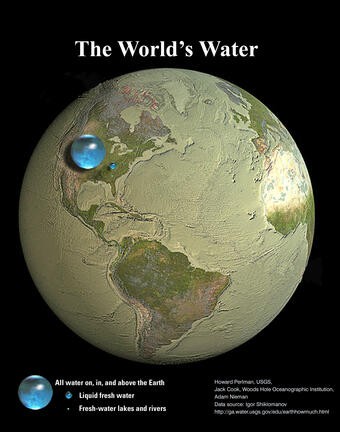The Earth is often called the “Blue Planet,” and for good reason. But just How Much Of The Earth Is Covered By Water? And where does all that water come from? The answer may surprise you.
 Earth's water in spheres comparing total, fresh liquid, and lake/river water
Earth's water in spheres comparing total, fresh liquid, and lake/river water
The Earth’s Watery Surface
Approximately 71% of the Earth’s surface is covered by water. This vast expanse includes oceans, seas, lakes, rivers, ice caps, glaciers, groundwater, and even the moisture in the air and within living organisms. The oceans alone hold about 96.5% of all the water on Earth.
Earth’s Water in a Bubble
It’s hard to visualize the volume of water on Earth. If you could gather all the water – oceans, ice, groundwater, lakes, rivers, and atmospheric moisture – into a single sphere, it would be about 860 miles (1,385 kilometers) in diameter. While substantial, this sphere is relatively small compared to the Earth’s overall size, illustrating how thin the layer of water actually is. The total volume of this water sphere would be approximately 332,500,000 cubic miles (1,386,000,000 cubic kilometers).
Consider only the liquid fresh water found in the ground, swamps, rivers, and lakes. This would form a sphere of just 169.5 miles (272.8 kilometers) in diameter, highlighting the relative scarcity of readily accessible fresh water. And the fresh water contained in all the lakes and rivers on the planet? That makes a bubble only 34.9 miles (56.2 kilometers) in diameter.
Water On and In the Earth
While surface water is readily visible, a significant portion of Earth’s water exists beneath our feet as groundwater. This hidden reservoir is crucial for maintaining river flows, even during dry periods. Precipitation seeps into the ground, replenishing aquifers and sustaining water flow in rivers through seepage.
Water Usage
Humans rely on both surface water and groundwater for various purposes. In the United States alone, billions of gallons of surface water and groundwater are used each day for drinking water, irrigation, and industrial processes. Groundwater is especially vital in arid regions where surface water is scarce.
Earth’s Water By The Numbers
Here are some facts to consider:
- Total Water Sphere: A sphere containing all of Earth’s water would be about 860 miles (1,385 kilometers) in diameter, with a volume of 332.5 million cubic miles (1,386 million cubic kilometers).
- Atmospheric Water: The atmosphere holds approximately 3,100 cubic miles (12,900 cubic kilometers) of water, primarily as water vapor. If it all fell as rain, it would cover the Earth with about 1 inch of water.
- Precipitation: The contiguous United States receives around 4 cubic miles (17.7 cubic kilometers) of precipitation daily.
- Evaporation/Transpiration: Each day, 280 cubic miles (1,170 cubic kilometers) of water evaporate or transpire into the atmosphere.
- Freshwater Distribution: Most of Earth’s freshwater is locked in glaciers and icecaps, with a significant amount stored as groundwater.
Global Water Distribution: A Detailed Look
The following table provides a more detailed breakdown of where Earth’s water is located. Notice the dominance of saline water in oceans and the significant proportion of freshwater locked up in ice and glaciers.
One Estimate of Global Water Distribution
(Percentages are rounded and may not add to 100)
| Water Source | Water Volume (cubic miles) | Water Volume (cubic kilometers) | % of Freshwater | % of Total Water |
|---|---|---|---|---|
| Oceans, Seas, & Bays | 321,000,000 | 1,338,000,000 | — | 96.54 |
| Ice Caps, Glaciers, & Permanent Snow | 5,773,000 | 24,064,000 | 68.7 | 1.74 |
| Groundwater | 5,614,000 | 23,400,000 | — | 1.69 |
| Fresh | 2,526,000 | 10,530,000 | 30.1 | 0.76 |
| Saline | 3,088,000 | 12,870,000 | — | 0.93 |
| Soil Moisture | 3,959 | 16,500 | 0.05 | 0.001 |
| Ground Ice & Permafrost | 71,970 | 300,000 | 0.86 | 0.022 |
| Lakes | 42,320 | 176,400 | — | 0.013 |
| Fresh | 21,830 | 91,000 | 0.26 | 0.007 |
| Saline | 20,490 | 85,400 | — | 0.006 |
| Atmosphere | 3,095 | 12,900 | 0.04 | 0.001 |
| Swamp Water | 2,752 | 11,470 | 0.03 | 0.0008 |
| Rivers | 509 | 2,120 | 0.006 | 0.0002 |
| Biological Water | 269 | 1,120 | 0.003 | 0.0001 |
Source: Igor Shiklomanov’s chapter “World fresh water resources” in Peter H. Gleick (editor), 1993, Water in Crisis: A Guide to the World’s Fresh Water Resources (Oxford University Press, New York).
Conclusion
While a significant portion of the Earth is covered in water, readily available freshwater is a precious resource. Understanding the distribution and movement of water is crucial for sustainable management and ensuring access to this vital element for future generations.